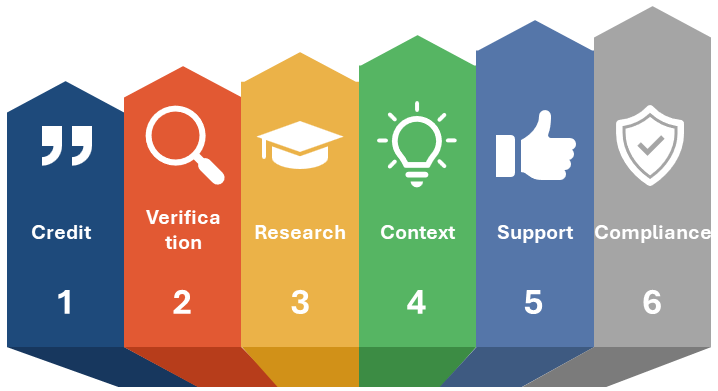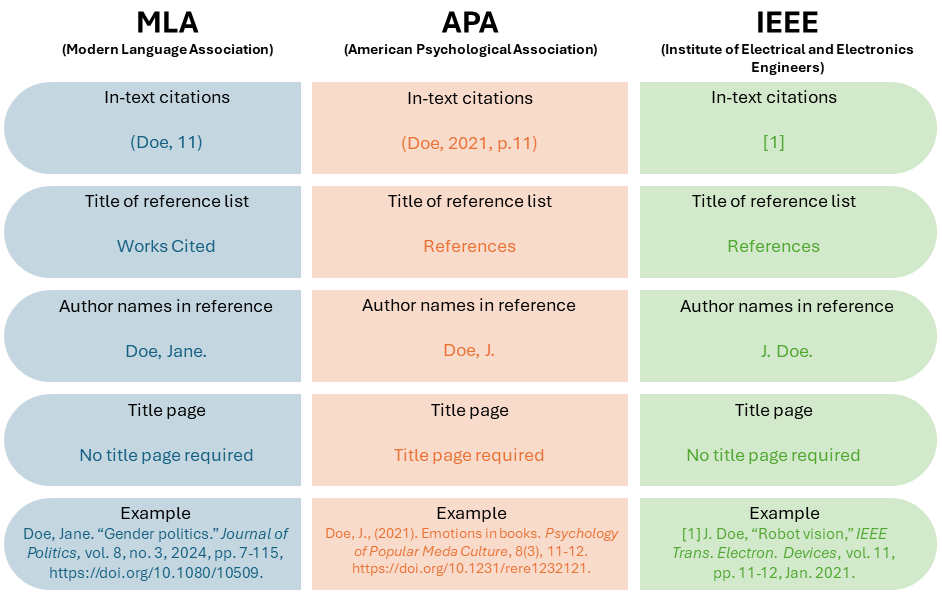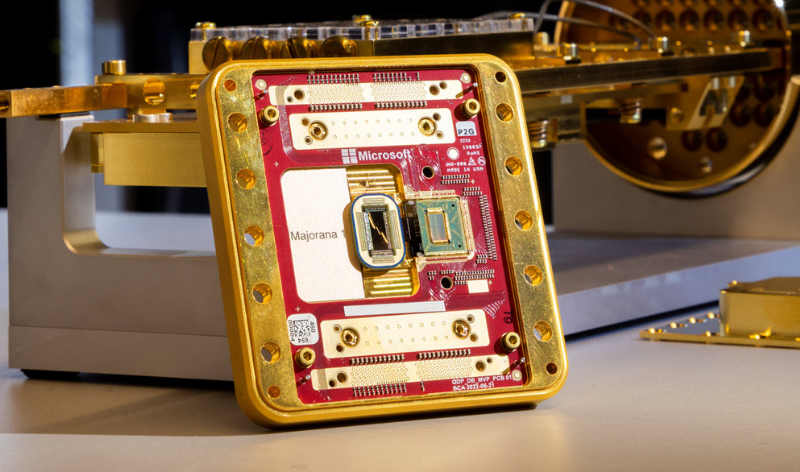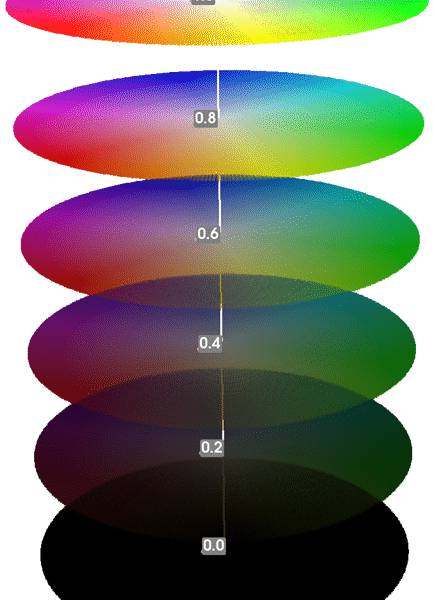When writing a manuscript or an article, you will have to deal with citations, references and creating a reference list. That can be cumbersome and complicated. To help you get startred, I will go over every all the details on what you need to know. There are also citation generators that make your life easier, such as Mendeley, or websites such as CiteThisForMe or MyBib, and it can even be done in MS Word. But it is always helpful to know what you are doing.
1. What is a source?
Anyone who writes an academic article or thesis, will use information obtained from somewhere else. Traditionally, these sources were mostly books, journals, encyclopedias, and other published materials. However, with the advent of the internet, the definition of a source has been expanded to include online resources such as e-books, online libraries, videos, and audio material. These resources can be classified as physical (printed) or online (digital) or text-based or visual/audio-based. It ultimately comes down to a resource from which you can obtain an intellectual idea that is not your own.
1.1 Where can I find these sources?
- Web of Science (formerly known as Web of Knowledge), is a database of online resources, such as journals, books, etc.
- Your university most likely has a paid subscription to a variety of journals that you can access online.
- Certain large journals, such as Nature Communication, have their articles accessable online for free.
- Your local (university) library.
- Google scholar
2. How to use references
2.1 In-text citations
When using information from other documents for your own academic text, you will have to “link” back to the original source you obtained it from. This is typically done using a shorthand notation within your own written text, referred to as an in-text citation. Different referencing styles have different ways of using in-text citations (see the next chapter for more information). These citations can also serve as signals to the reader, indicating that a source is being used. For example, including the author’s name in the phrase that introduces the topic, such as “Fink et al. argued that…”.
When using a direct quotation from a source, it is important to enclose the text in quotation marks. When paraphrasing or summarizing a source, it is still necessary to cite it, but quotation marks are not needed. However, there is an important difference between paraphrasing and citation, which should be carefully considered.
It is not necessary to cite your own intellectual ideas or work unless they have been previously published. Similarly, common knowledge, or information that the reader does not need to look up, does not need to be cited.
At the end of your work, it is essential to include a reference list or bibliography that provides detailed information on how to locate the original sources.
2.2 Why citations?

References and citations are important to use in academic writing for several reasons:
- To give credit to the original authors of the ideas and information used in the work. This is a basic principle of academic integrity and helps to avoid plagiarism.
- To allow readers to verify and locate the original sources and conduct further research. This enhances the credibility of the work and allows readers to fact-check and verify the information presented.
- To demonstrate the breadth and depth of the research conducted. A well-referenced work shows that the author has done their due diligence and has a good understanding of the literature on the topic.
- To provide context and background information. Citations and references can provide additional context and background information to help readers understand the significance of the ideas presented in the work.
- To support the arguments and claims made in the work. Citing sources can provide evidence and support for the arguments and claims made in the work, making it more convincing and credible.
- To comply with academic conventions and guidelines. In most academic fields, it is expected that work will be properly referenced and cited, failure to do so is considered as a violation of academic integrity. Faculty members of your university have access to “turnitin“, which checks your work against other articles, millions of websites, papers, etc.
2.3 Reference list
All the in-text citations have to match with a list of all used sources, normally located at the end of the paper or manuscript. This reference list (or “Work Cited” list) is where you provide all the details of your sources in an organized fashion. The information of each source includes:
- Author
- Title of the work
- Date
- Container
- Location (where you found it).
3. Referencing styles
Since there is no universal referencing style, it is important to check your university’s guidelines when choosing which one to use. Below I detailed three different styles (out of many), and the main studies that use them. If you are still unsure, the best approach is to ask your professor or teaching assistant which style they prefer. If there is no specific guidance, it is recommended to use the APA style and maintain consistency throughout your work.
In the section below, we will provide a brief overview of different referencing style, with links to the different articles that explain in more depth what to expect. Chosing a style means you have to adhere to that specific format. Besides the referencing style, this include topics such as specific font size, spacing, and of course the type of reference or bibliography list at the end of the academic text.
MLA
English
Literature
Foreign Language
Religious studies
APA
Psychology
Education
Business
Nursing
Linguistic Studies
IEEE
Engineering
Computer Science
Information Science
The Modern Language Association (MLA) format is a standardized style used primarily in the humanities for writing and citing sources. It requires in-text citations that include the author’s last name and the page number, like this: (Johnson 23). This refers readers to the Works Cited page, where full source details are listed. For example,
- a book citation might appear as: Johnson, Emily. History of Art. Random House, 2019.
- Additionally, an article citation would be formatted as: Williams, Sarah. “Modern Literature Trends.” Journal of Arts, vol. 15, no. 3, 2021, pp. 45-67.
MLA also specifies document formatting, such as 1-inch margins, double spacing, and a header with your last name and page number. These guidelines help ensure consistency and professionalism in academic writing.
The American Psychological Association (APA) the 7th edition format is widely used in the social sciences for writing and citing research papers. In APA, in-text citations include the author’s last name and the year of publication, such as (Smith, 2020). This points the reader to the full citation on the References page, which provides complete source details. For instance,
- a book citation in APA would be formatted as: Smith, J. (2020). The Science of Psychology. Wiley.
- Additionally, an article citation would look like: Johnson, L. (2019). The impact of technology on education. Journal of Educational Research, 58(4), 123-134.
APA also requires specific formatting, including 1-inch margins, double-spacing, a title page, and a running head with a shortened title and page number. These standards promote clarity and uniformity in scholarly writing.
The Institute of Electrical and Electronics Engineers (IEEE) format is commonly used in technical fields, particularly engineering and computer science. In IEEE, in-text citations are numbered in square brackets in the order of appearance, like this [1]. These numbers correspond to the full references listed at the end of the document. For example,
- a book citation in IEEE format would appear as: [1] J. Smith, Introduction to Electrical Engineering, 3rd ed., New York: McGraw-Hill, 2018.
- Additionally, a journal article citation would look like: [2] L. Johnson, “Advances in Artificial Intelligence,” IEEE Transactions on Neural Networks, vol. 30, no. 2, pp. 123-130, Feb. 2021.
IEEE format also specifies using a specific font, such as Times New Roman, along with 10-point font size, single spacing, and numbered headings to organize content. This format ensures precision and consistency in technical documentation.

4. Plagiarism
Presenting someone else’s work or intellectual ideas as your own without proper citation constitutes plagiarism, whether it is done with or without the original author’s permission. This applies to all forms of published and non-published work, such as reports. Plagiarism is a serious disciplinary offense and can result in penalties, including suspension from studies. There are several forms of plagiarism, and even if it is unintentional, there may still be an academic penalty for poor citation practices.
It is important to note that the use of references and citations is not limited to texts, but applies to all types of media, such as computer code, websites, manuscripts, or a fellow student’s report.
To avoid plagiarism and ensure academic integrity, it is essential to start learning proper citation techniques early on in your academic career. When first starting as a student, it may feel overwhelming to have to cite everything, and reports may become cluttered with citations. This is normal, and it shows that you are actively engaging with the topic. With time and experience, you will learn how to think critically and assess which arguments are most relevant, allowing you to draw your own conclusions.
Dissertation menu
- Dissertation Title Page | Tips & Examples
- Dissertation Preface / Acknowledgements | Tips & Examples
- Dissertation Abstract | Tips and Examples
- Dissertation Table of Content | Tips and Example
- Dissertation Figure and Table List | Tips and Examples
- Dissertation List of Abbreviations | Tips and Example
- Dissertation Introduction | Tips and examples
- Dissertation Literature Review | Tips and Example
- Dissertation methodology | Tips and Example
- Dissertation Research Results | Tips and Example
- Dissertation Discussion | Tips and Example
- Dissertation Conclusion | Tips and Example
- References & Citations
- Dissertation Appendix | Tips and Example

















